My Research
I do research simply because I like to have an answer to the question “why” – or “how come”. This question came over me already when I started to use a hobby telescope I got at twelve years of age. This was also the reason that I as a fresh PhD student in experimental physics started to get involved in molecular calculations – I could not give up the hope to explain ALL the bands in the X-ray emission spectrum of the water molecule I just had recorded.
I now try to answer the question “why” using theoretical models where every electron, atom or molecule can make a difference, or, at a different scale, I try to interpret modeling results in terms of chemical structure, properties and dynamics. Here I struggle with the problem that while Quantum Mechanics is the deepest and widest description of nature we have available today, it is limited to small (OK, maybe not that small) systems and to zero temperature. I try to deal with this situation by using models that combine quantum and classical physics, where we join the accuracy of the former with the applicability of the latter. Here classical physics can mean molecular Newtonain dynamics, Maxwellian wave mechanics, statistical mechanics or dielectric principles. In this realm we apply the Scandinavian style of property calculations (response, propagators, inner projections) to search for and understand light- matter interaction at larger scales in space and time. We use that understanding to explore molecular properties and spectroscopy and to design molecular probes in different wavelength regions, for instance spin-labels building on magnetic resonance effects in the radio-frequency region – vibrational fingerprints given by the Raman effect - optical absorption and fluorescence relying on the two-photon principle - all the way down to the X-ray wavelength region, where I once started, but where theory now touches on the fantastic opportunities offered by modern synchrotron radiation sources and X-ray free electron lasers. These quantum-classical approaches have secure applications in a wide variety of applied research areas, in chemistry, biotechnology, biomedicine and material science. Thus, in addition to interpreting experiment by answering “why”, we have now come close to the point of true predictive modeling.
Some Ongoing Research Projects:
Quantum Mechanics Capacitance Molecular Mechanics
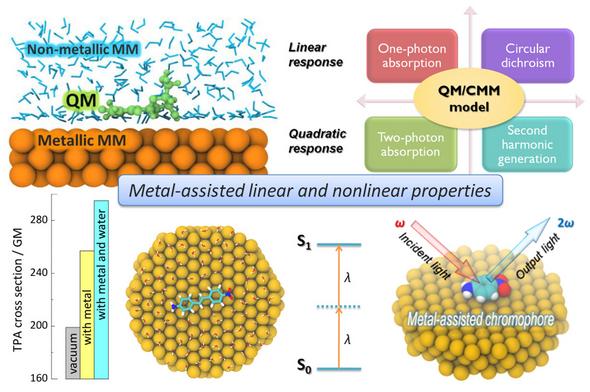
We introduce a quantum mechanics capacitance molecular mechanics (QMCMM) approach for computation of linear and nonlinear optical properties of molecules in heterogeneous environments, such as metal surfaces or nanoparticles embedded in solvents. The new thing with respect to "ordinary" QMMM is the "C" - the capacitance force field - which can reguate charge flow and charge transfer in the environment. This approach enables studies of properties and spectra of systems embedded in or placed at arbitrary shaped metallic surfaces, clusters, or nanoparticles. Combined with linear and quadratic response theory, the QMCMM approach has been employed in multiscale modelling of properties like one-photon absorption[1], circular dichroism absorption[2], second harmonic generation[3], two-photon absorption[4]. We can here study the combined effect of a metal, organic or solvent enrvironment, how they directly affect the property in question, or how that is accomplished indirectly through induced changes in molecular structure or change in the orientation and sampling of the molecule. The QMCMM approach is now used to design composite functional materials consisting of organic and inorganic counterparts, which can serve as materials for nonlinear optics with applications in bio maging and sensing.
References
- [1] Z. Rinkevicius, X. Li, J.A.R. Sandberg, K.V. Mikkelsen, and H. Ågren. A Hybrid Density Functional Theory/Molecular Mechanics Approach for Linear Response Properties in Heterogeneous Environments. J. Chem. Theory Comput., 2014, 10, 989–1003.
- [2] X. Li, Z. Rinkevicius, and H. Ågren. Electronic Circular Dichroism of Surface-Adsorbed Molecules by Means of Quantum Mechanics Capacitance Molecular Mechanics. J. Phys. Chem. C, 2014, 118, 5833–5840.
- [3] Z. Rinkevicius, X. Li, J.A.R. Sandberg, and H. Ågren. Non-linear optical properties of molecules in heterogeneous environments: a quadratic density functional/molecular mechanics response theory. Phys. Chem. Chem. Phys., 2014, 16, 8981–989.
- [4] X. Li, Z. Rinkevicius, and H. Ågren. Two-Photon Absorption of Metal-Assisted Chromophores. J. Chem. Theory Comput., DOI: 10.1021/ct500579n
Atmospheric Aerosol Chemistry
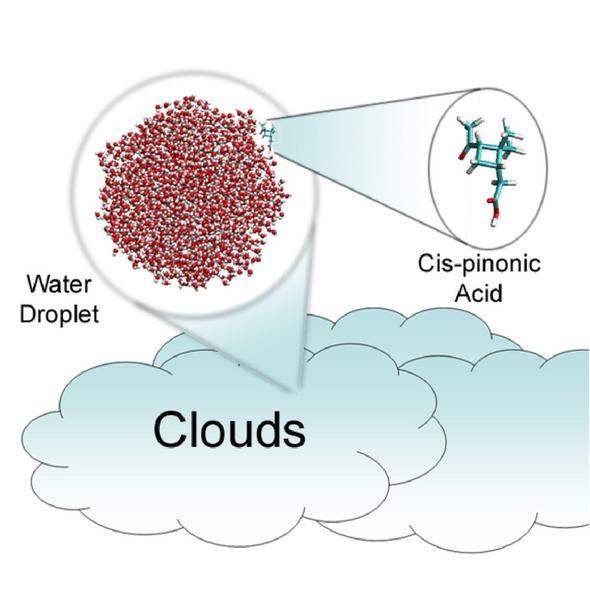
We use molecular simulations, MD and QM/MM, to explore the nucleation, growth, stability, light absorption and light scattering properties of composite atmospheric particles and aerosols. The goal of the research is to contribute to the microscopic understanding of climate issues, like green house effect, albedo and cloud formation. In particular, we study configurations and interfacial properties of composite nano-droplets, for instance those containing ions and amino acids, which are capable of acting as cloud condensation nuclei under atmospheric conditions. We compute activation energy and surface tension parameters entering so-called Köhler theory for supersaturation. QM/MM response theory is used for exploring light absorption of compounds, natural or man-made, when they absorb into atmospheric water clusters. Light scattering of the clusters is obtained by constructing a classical cluster scattering tensor from decomposed frequency-dependent hyperpolarizabilities of water and the foreign substance, which in turn are derived by quantum chemistry.
References
- [1] X. Li, T. Hede, Y. Tu, C. Leck, and H. Ågren. Surface-Active cis-Pinonic Acid in Atmospheric Droplets: A Molecular Dynamics Study. J. Phys. Chem. Lett., 2010, 1, 769-773.
- [2] X. Li, T. Hede, Y. Tu, C. Leck, and H. Ågren. Glycine in aerosol water droplets: a critical assessment of Köhler theory by predicting surface tension from molecular dynamics simulations. Atmos. Chem. Phys., 2011, 11, 519-527.
- [3] T. Hede, X. Li, C. Leck, Y. Tu, and H. Ågren. Model HULIS compounds in nanoaerosol clusters - investigations of surface tension and aggregate formation using molecular dynamics simulations. Atmos. Chem. Phys., 2011, 11, 6549-6557.
- [4] L. Sun, X. Li, T. Hede, Y. Tu, C. Leck, and H. Ågren. Molecular Dynamics Simulations of the Surface Tension and Structure of Salt Solutions and Clusters. J. Phys. Chem. B, 2012, 116, 3198-3204.
- [5] T. Hede, C. Leck, L. Sun, Y. Tu, and H. Ågren. A theoretical study revealing the promotion of light-absorbing carbon particles solubilization by natural surfactants in nanosized water droplets. Atmos. Sci. Lett. 14, 86-90.
- [6] X. Li, C. Leck, L. Sun, T. Hede, Y. Tu, and H. Ågren. Cross-Linked Polysaccharide Assemblies in Marine Gels: An Atomistic Simulation. J. Phys. Chem. Lett. 2013, 4, 2637-2642.
- [7] X. Li, T. Hede, Y. Tu, C. Leck, and H. Ågren. Cloud droplet activation mechanisms of amino acid aerosol particles: insight from molecular dynamics simulations. Tellus B, 2013, 65, 20476.
- [8] L. Sun, T. Hede, Y. Tu, C. Leck, and H. Ågren. Combined Effect of Glycine and Sea Salt on Aerosol Cloud Droplet Activation Predicted by Molecular Dynamics Simulations. J. Phys. Chem. A, 2013, 117, 10746-10752.
- [9] L. Sun, X. Li, T. Hede, Y. Tu, C. Leck, and H. Ågren. Molecular dynamics simulations reveal the assembly mechanism of polysaccharides in marine aerosols. Phys. Chem. Chem. Phys., 2014, 16, 25935-25941.
- [10] T. Hede, N.A. Murugan, J. Kongsted, C. Leck, and H. Ågren. Simulations of Light Absorption of Carbon Particles in Nanoaerosol Clusters. J. Phys. Chem. A, 2014, 118, 1879-1886.
Virtual Laboratory for Molecular Probes
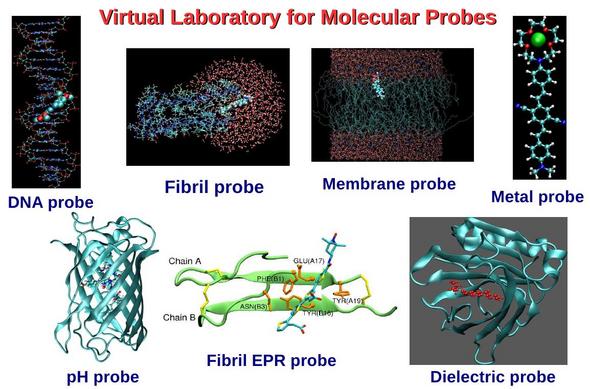
It is of paramount importance to early diagnose diseases to treat them in a non-invasive and inexpensive, and so to save human suffering. The pathological state of any disease is often connected to number of events at the microscopic level such as aberrant expression of specific enzymes and conformational changes in specific biomolecular structures, dielectric variation and changes in physiological condition such as pH, ionic concentration and their distribution. While it is impractical to observe these “disease indicator events” through naked eye, they can be indirectly monitored through following the dynamics and distribution of “diagnostic agents” which have specific affinity to the target bio-structures and sensitivity to change in physiological condition connected to the early stage of the disease. In addition, it is of importance that these probes have characteristic spectroscopic properties when bound to the bio-structures and in specific physiological conditions so that changes in spectroscopic parameters can be used as diagnostic parameters for a specific disease. Currently available diagnostic agents are based on MRI, PET, CT and SPECT imaging techniques and often involve the usage of heavy metals and radio-active nuclei. We are working with the design bio-friendly diagnostic agents for imaging based on spectroscopy, in particular fluorescence, two-photon absoprtion, second harmonic generation and eletron paramagnetic resonance spectroscopies. Much can be learned through computational modeling concerning the interaction of various molecular probes and their interaction with specific targets and also about the properties of probes in their biostructure bound state. For example, structure-property relationships for various molecular probes can be established which can be used to propose novel probes for those biostructures relevant for specific diseases. We aim to design novel spectroscopic probes for many biomacromolecular targets like enzymes, membranes, DNA and misfolded forms of proteins. The aim is to model and design the probes for imaging and sensing due to the strong correlation of these “physiological parameters” with a number of diseases. Our strategy is to choose the molecules which are already known to have binding affinity to these targets and improve their properties by tuning the structure but without affecting the affinity significantly. We have long standing experience in modeling linear and non-linear optical properties of molecules (both intrinsic and and extrinsic) in the presence of bio-environments[1-6]. We have developed a most sophisticated integrated approach involving hybrid quantum mechanics and molecular mechanics technique which can account for various molecular processes and include all interactions between the probe and bio subsystems during the modeling of structure and dynamics. This allows us to model the structure, dynamics and properties of the molecular probes relevant for membrane and enzyme targeting, pH and metal sensing, accurately in presence of bio-environments or in a specific physiological condition in a realistic way[1-6].
References
- N. Arul Murugan, R. Zalesny, J. Kongsted and H. Ågren, Chelation-induced quenching of two-photon absorption properties of azacrown ether substituted distyryl benzene for metal ion sensing., J. Chem. Theory Comput., 10(2), 778(2014).
- N. Arul Murugan, J. Kongsted, H. Ågren, pH-Induced Modulation of One- and Two-Photon Absorption Properties in a Naphthalene-Based Molecular Probe, J. Chem. Theory Comput., 9(8), 3660 (2013)
- N. Arul Murugan, R. Apostolov, Z. Rinkevicius, J. Kongsted, Erik Lindahl and H. Ågren, Association dynamics, linear and non-linear optical properties of an N-acetylaladanamide probe in a POPC membrane. J. Am. Chem. Soc., 135 (36), 13590(2013).
- N. Arul Murugan, J. Kongsted, Z. Rinkevicius, and H. Ågren, Color modeling of protein optical probes. Phys. Chem.Chem. Phys. (Communication), 14, 1107(2012).
- N. Arul Murugan, S. Schrader and H. Ågren, Role of protonation state and solvation on the pH dependent optical properties of Bromocresol green, J. Chem. Theor. Comp. 10(9), 3958–3968. (2014)
- I. Harczuk, N. Arul Murugan, O. Vahtras and H. Ågren, Studies of pH-sensitive optical properties of the deGFP1 green fluorescent protein using a unique polarizable force field, J. Chem Theory Comput. 10 (8), 3492–3502 (2014)
- X. Li, Z. Rinkevicius, J. Kongsted, N. Arul Murugan and H. Ågren, Binding Mechanism and Magnetic Properties of A Multifunctional Spin Label for Targeted EPR Imaging of Amyloid Proteins: Insight from Atomistic Simulations and First-Principles Calculations, J. Chem. Theory Comput. 8, 4766–4774 (2012)
Upconverting Nanoparticles for Solar Energy and Health Care Applications

Few scientific endeavours have transformed our perception of nature like the development of nanoscience. Materials structured at the nanoscale possess unique physiochemical attributes and provide unprecedented capabilities that nowadays are exploited in many important societal areas, like healthcare, environmental research and energy conversion. The success of nanotechnology can essentially be traced to two outstanding properties of nanoparticles: quantum confinement, leading to discrete energy states, and the ability to support collective electron oscillations - plasmons. In this project we emphasize a third dimension of nanotechnology that recently has emerged, namely the ability of specifically designed nanoparticles to efficiently and selectively convert incoming light into other parts of the wavelength spectrum. Our project is formulated around some outstanding features of specifically designed such nanoparticles that sequentially can absorb two or more photons via real intermediate long-lived electronic states to produce one shorter wavelength photon upon emission. These nanoparticles efficiently operate with incoherent light in the infrared wavelength region at low excitation power – features that promote their use in high-contrast deep tissue bioimaging, optogenetics, photovoltaics and many other areas. Our project utilizes and advances the state-of-art in experimentation and modeling to control light and energy transfer in rare earth complexes and explores their functionality in terms of chemical and electronic structure and of extended environments. The outcome refers to new generation efficient IR-to-visible upconverting nanomaterials with a judicious control of the emission colors to act as on-demand and on-site optical nanotransformers for applications ranging from photovoltaics for sustainable energy, to bioimaging and light activation for diagnostics and therapy, to novel nanotechnology areas like optogenetics.
References
- [1] Ultrasmall monodisperse NaYF4:Yb3+/Tm3+ nanocrystals with enhanced near-infrared to near-infrared upconversion photoluminescence, G. Chen, T. T. Ohulchanskyy, R. Kumar, H. Ågren, and P. N. Prasad, ACS Nano, 4, 3161 (2010).
- [2] (α-NaYbF4:Tm3+)/CaF2 Core/Shell Nanoparticles with Efficient Near-Infrared to Near-Infrared Upconversion for High-Contrast Deep Tissue Bioimaging, G. Chen, J. Shen, T. Y. Ohulchanskyy, N. J. Patel, A. Kutikov, Z. Li, J. Song, R. Pandey, H. Ågren, P. N. Prasad and G. Han, ACS Nano, 6, 8280 (2012).
- [3] Monodisperse NaYbF4:Tm3+/NaGdF4 core/shell nanocrystals with near-infrared to near-infrared upconversion photoluminescence and magnetic resonance properties, G. Chen, T. Ohulchanskyy, W.C. Law, H. Ågren and P. N. Prasad, Nanoscale, 3, 2003 (2011).
- [4] Intense visible and near-infrared upconversion photoluminescence in colloidal LiYF4:Er3+ nanocrystals under excitation at 1490 nm, G. Chen, T. T. Ohulchanskyy, A. Kachynski, H. Ågren, and P. N. Prasad, ACS Nano, 5, 4981 (2011).
- [5] Core/Shell NaGdF4:Nd3+/NaGdF4 Nanocrystals with Efficient Near-Infrared to Near-Infrared Downconversion Photoluminescence for Bioimaging Applications, G. Chen, T. Y. Ohulchanskyy, S. Liu, W. C. Law, F. Wu, M. Swihart, H. Ågren and P. N. Prasad, ACS Nano, 6, 2969 (2012).
- [6] Use of colloidal upconversion nanocrystals to energy relay solar cell light harvesting in the near infrared region, C. Yuan, G. Chen, P.N. Prasad, T. Y. Ohulchansky, Z. Ning, H. Tian, L. Sun and H. Ågren. J. Mater. Chem., 22, 16709-16713 (2012).
- [7] (α-NaYbF4:Tm3+)/CaF2 Core/Shell Nanoparticles with Efficient Near-Infrared to Near-Infrared. Upconversion for High-Contrast Deep Tissue Bioimaging. G. Chen, J. Shen, T.Y. Ohulchanskyy, N. Patel, J. Song, R.K. Pandey, H. Ågren, P. N. Prasad and G. Han, ACS Nano, 6, 8280 (2012).
- [8] Intense Ultraviolet Upconversion Emission from Water-Dispersed Colloidal YF3:Yb3+/Tm3+ Rhombic Nanodisks, H. Qiu, G. Chen, R. Fan, L. Yang, C. Liu, S. Hao, M. J. Sailor, H. Ågren, C. Yang and P. N. Prasad, Nanoscale, 6, 753-757 (2014).
- [9] Enhanced Upconversion Luminescence in Yb3+/Tm3+-Codoped Fluoride Active Core/Active Shell/Inert Shell Nanoparticles through Directed Energy Migration, H. Qiu, C. Yang, W. Shao, J. Damasco, X. Wang, H. Ågren, P. N. Prasad and G. Chen, Nanomaterials, 4, 55-68 (2014).
- [10] Enhanced upconversion emission in colloidal (NaYF4:Er3+)/NaYF4 core/shell nanoparticles excited at 1523 nm, W. Shao, G.Y. Chen, J. Damasco, X.L. Wang, A. Kachynski, T.Y. Ohulchanskyy, C.H. Yang, H. Ågren and P.N. Prasad, Optics Letters, 39, 1386-1389 (2014).
- [11] Upconversion in Core-Shell Nanostructures: Nanophotonics Control, Nanochemistry, and Applications, G. Chen, H. Ågren and P. N. Prasad, Chem. Soc. Reviews 00, 000 (2014).
- [12] Simultaneous Multiple Wavelength Upconversion in a Core-Shell Nanoparticle for Enhanced Near Infrared Light Harvesting in a Dye-Sensitized Solar Cell, C. Yuan, G. Chen, Guanying, L. Li, J. Damasco, Z. Ning, H. Xing, T. Zhang, L. Sun, Licheng, H. Zeng, A. Cartwright, P. N. Prasad and H. Ågren, ACS Appl. Mater. Interfaces, DOI: 10.1021/am504866g (2014).
- [13] Size-Tunable and Monodisperse Tm3+/Gd3+-Doped Hexagonal NaYbF4 Nanoparticles with Engineered Efficient Near Infrared-to-Near Infrared Upconversion for In Vivo Imaging, J. A. Damasco, G. Chen, W. Shao, H. Ågren, H. Huang, W. Song, J. F. Lovell, P. N. Prasad, ACS Appl. Mater. Interfaces, DOI: 10.1021/am503288d (2014).
Modelling design of biomolecular markers targeting Alzheimer's disease
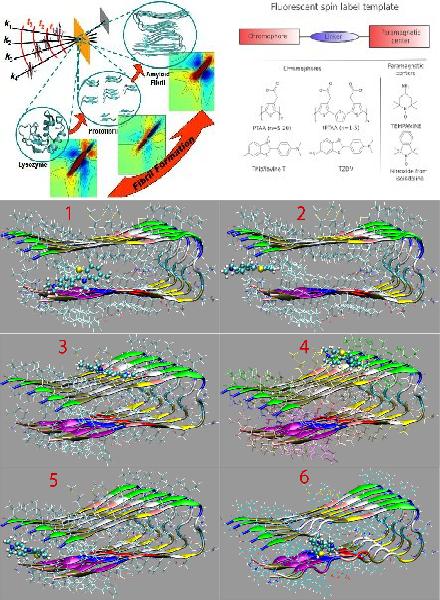
Alzheimer's disease is a neuro degenarative disease associated with cognitive impairment and dementia and poses a major challenge to current human healthcare. The deposits and accumulation of insoluble plagues of amyloid and tau proteins in and around neurons in the brain have been attributed as the cause for this disease. There is therefore a major thrust to design molecular probes to target amyloid and tau oligomers and fibrils for the purpose of diagnosis and to identify the stage of disease development. Unfortunately, not many potential diagnostic agents have so far become available. Our motivation for the present project is to propose fibril specific diagnostic agents with improved binding affinity and characteristic spectroscopic properties for quatitative estimate of fibrils. We use multiscale QM/MM modeling of molecular probes that can strongly and specifically bind to these amyloid and tau oligomers and their respective fibrils. We study how various known molecular probes such as congored, thioflavin-T, PIB, AZD specifically interact with fibril targets, based on which we propose structural motifs suitable for targeting oligomers and fibrils. The binding sites in oligomers and fibrils and binding pose and mode of the diagnostic agents are thus studied in detail. Furthermore, the drug development also requires a quantitative estimation of fibrils so that activity and relative binding affinity of the candidate-drug molecules can be measured. Such quantitative estimates of fibrils can be monitored by following spectroscopic signals of appropriate diagnostic agents. We use QM/MM response theory for this purpose to study fluorscence, EPR, SHG and two-photon absorption probes, or multifunctional such probes, which combine two such spectroscopic modes. By comparing with experiments these calculations can also highlight or rule out possible binding site. The project is carried out in collaboration with KI and Uppsala university in two formalized projects, supported by SSF and SLL.
References
- [1] N. Arul Murugan, Magnus, J. Kongsted, Z. Rinkevicius, K. Aidas and H. Ågren, Amyloid fibril induced structural and spectral modifications in Thioflavin-T optical probe. J. Phys. Chem. Lett., 4, 70(2013).
- [2] N. Arul Murugan, Robert Zalesny, Jacob Kongsted, Agneta Nordberg and Hans Ågren, Promising two-photon probes for in-vivo detection of beta amyloid deposits. Chem. Comm., 50, 11694-11697 (2014)
- [3] X. Li, Z. Rinkevicius, J. Kongsted, N. Arul Murugan and H. Ågren, Binding Mechanism and Magnetic Properties of A Multifunctional Spin Label for Targeted EPR Imaging of Amyloid Proteins: Insight from Atomistic Simulations and First-Principles Calculations, J. Chem. Theory Comput. 8, 4766–4774 (2012)
Strong field physics and new states of matter
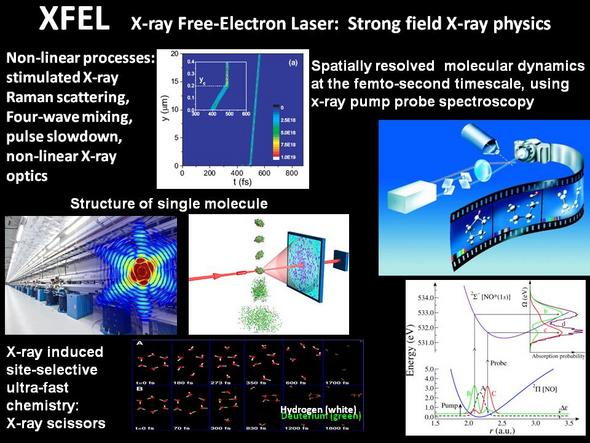
Our project is motivated by the progress in fourth-generation synchrotron facilities and free-electron X-ray lasers around the world. It aims to develop a theory and simulation techniques relevant for the interpretation of the new experimental data in order to stimulate the process of scientific discovery in this field. Our proposal builds on an active collaboration and synergy between the leading theoretical groups in Sweden, as well as with synchrotron and XFEL users in Sweden and around the world. A strong focus will be put on developing and extending computational techniques and programs which target physical processes of key importance in future experimental activities in the area, such as resonant inelastic X-ray scattering [1], nonlinear X-ray scattering and absorption [2-5,8-10], electron dynamics in strong fields [6] as well as X-ray induced chemistry and molecular dynamics [7,8]. These techniques will then be applied to analyze and interpret data from experimental studies of new materials, biomolecules in relevant environments, the kinetics of phase transitions, heterogeneous catalysis as well as the properties of liquids and solutions. Our hope is that the project, will enrich the expected scientific output from the new X-ray facilities. The project, CoTXS, is supported by the Knut and Alice Wallenberg foundation.
References
- 1. J.-C. Liu, Y. Velkov, Z. Rinkevicius and F. Gel'mukhanov, Resonant inelastic X-ray Raman scattering induced by Rabi flopping of core hole, Chem. Phys. Lett. 453, 117 (2008).
- 2. Y.-P. Sun, J.-C. Liu and F. Gel’mukhanov, Slowdown and compression of a strong X-ray free-electron pulse propagating through the Mg vapors, EuroPhys. Lett., 87, 64002 (2009).
- 3. Y.-P. Sun, J.-C. Liu and F. Gel’mukhanov, The propagation of a strong x-ray pulse followed by pulse slowdown and compression, amplified spontaneous emission and lasing without inversion, J. Phys. B: At. Mol. Opt. Phys., 42, 201001 (2009).
- 4. Y.-P. Sun, J.-C. Liu, C.-K. Wang and F. Gel'mukhanov, Propagation of a strong x-ray pulse: Pulse compression, stimulated Raman scattering, amplified spontaneous emission, lasing without inversion, and four-wave mixing, Phys. Rev. A, 81, 013812 (2010).
- 5. Y.-P. Sun, Z. Rinkevicius, C.-K. Wang, S. Carniato, M. Simon, R. Taïeb and F. Gel'mukhanov, Two-photon-induced x-ray emission in neon atom, Phys. Rev. A 82, 043430 (2010).
- 6. J.-C. Liu, Y.-P. Sun, C.-K. Wang, H. Ågren and F. Gel’mukhanov, Auger effect in the presence of strong x-ray pulses, Phys. Rev. A, 81, 043412 (2010).
- 7. Q. Miao, J.-C. Liu, H. Ågren, J.-E. Rubensson, and F. Gel’mukhanov, Dissociative X-ray Lasing, Phys. Rev. Lett. 109, 233905 (2012).
- 8. V. Kimberg and N. Rohringer, Amplified X-Ray Emission from Core-Ionized Diatomic Molecules, Phys. Rev. Lett. 110, 043901 (2013).
- 9. V. Kimberg, S. B. Zhang and N. Rohringer, X-ray lasing in the CO molecule, J. Phys. B: At. Mol. Opt. Phys. 46 164017 (2013).
- 10. V. Kimberg, S. B. Zhang and N. Rohringer, X-ray lasing in diatomic molecules, J. Phys.: Conf. Ser. 488 012025 (2014).